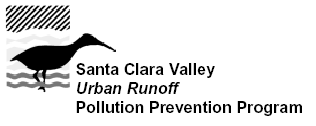Stormwater Runoff
- Vehicle Brake Pads
- Architectural Copper
- Pool/Spa/Fountain Algaecides
- Copper Pesticides
- Industrial Copper Use
- Soil Erosion
- Mobile Cleaning
- Vehicle Washing
- Vehicle Services
Discharges to POTWs
Shoreline Activities
Copper Pesticides
Copper-containing pesticides are widely used to control fungi, algae and roots. Common applications include controlling fungi on plants; controlling roots and other plant growth in sewers; controlling algae in swimming pools, ponds and lakes; controlling aquatic plant growth on boat hulls; serving as biocides in commercial products; and preventing rot and mildew on wood, roofing and other outdoor surfaces. As of February 2004, there were approximately nineteen copper-containing pesticide active ingredients in products registered for sale in California.
It is believed that copper pesticides washed off in stormwater runoff contribute a very small fraction of copper to San Francisco Bay. It is assumed that the runoff fraction from copper fungicides and copper wood preservatives is 0.5 to 1 percent. In contrast, copper based algaecides are directly applied to many types of waterbodies, some with a high potential to release copper to urban runoff or San Francisco Bay. The primary algaecide applications are to shoreline lagoons and sloughs, reservoirs and water supply conveyance channels, industrial systems (e.g., irrigation ponds, cooling towers) and swimming pools, spas and fountains.
Stormwater Control Measures
Control measures to prevent releases of copper pesticides into stormwater runoff include the following:
- Public outreach
discouraging the use of copper algaecides for pools, spas and fountains
applications.
- Encouraging the
discharge of copper-containing pool, spa and fountain water to the sewer
system where permitted.
- Reducing the use
of copper algaecides applied to surface waters.
Wastewater Control Measures
The release of copper-containing pesticides to a Publicly Owned Treatment Works is unlikely to occur. In 1995, the sale and use of copper containing root control products in the San Francisco Bay Area was banned.
Best Management Practices
Control measures are available for all types of copper pesticide uses. Within the San Francisco Bay area, control measures have focused on the following copper algaecide uses:
- Algaecides for pools, spas and fountains - Refer to the web page entitled Pool/Spa/Fountain Algaecides.
- Other algaecides applied to surface waters - The primary control measure for copper-based pesticides applications to surface waters is the Aquatic Pesticide General Permit Program (managed by the State and Regional Water Quality Control Boards). The aquatic pesticide general permit, which was adopted May 20, 2004 (Water Quality Order No. 2004-0009-DWQ), requires an SWRCB Aquatic Pesticides Application Plan describing BMPs to mitigate effects to water quality resulting from pesticide application, monitoring and reporting of pesticide applications and monitoring results to the Regional Board Water Quality Control Board. Copper algaecide use has reportedly declined significantly since the adoption of these and prior aquatic pesticide permit requirements.
- Alternative algae control methods - Aquatic pests can also be controlled with biological, physical and mechanical control methods, non-conventional chemical control methods and/or preventive measures. However, these alternative control measures have the potential to impact water quality and aquatic habitats adversely. As a result, appropriate alternative methods should be identified on a site-by-site basis and tested prior to transitioning to a non-copper control methods.
- Copper landscaping pesticides - Currently, there are few control measures to address copper-based pesticides in landscaping. Some municipal integrated pest management (IPM) policies include measures to limit use of copper-based pesticides. Since copper-based landscaping pesticides are often less toxic to humans than alternative pesticides, any transition away from copper landscaping pesticides should be managed with caution.
- Copper wood
preservatives - The phase-out of chromated copper arsenate (CCA)
wood preservatives has stimulated a transition to other copper-based
wood preservatives. One potential option is to consider developing best
management practices to minimize the use of copper wood preservatives
where releases are most likely to occur.
